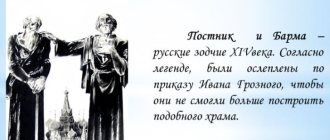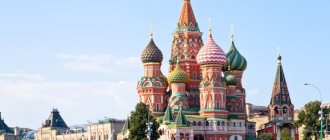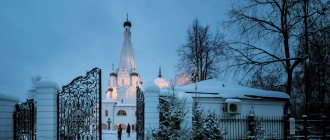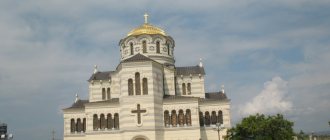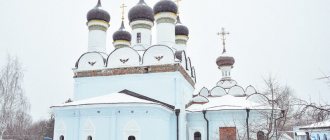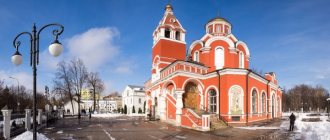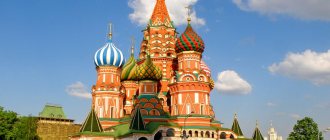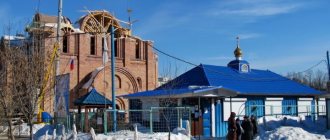The Orthodox Church stands out brightly in the vastness of Moscow's Red Square and is a famous monument of Russian architecture. The cathedral was erected on the special instructions of Tsar John IV in honor of the campaign against Kazan and the capture of the city. Next to the building there was a deep ditch, so the common people called the temple the Intercession on the Ditch.
The magnificent church unites ten chapels, some of them are consecrated in honor of the saints of the Russian Orthodox Church. Today, the grandiose structure is considered a UNESCO property and operates as a division of the history museum.
History of construction
When John IV made campaigns against Kazan, which belonged to the Tatars, wooden churches were erected on (Red) Trinity Square, symbolizing the victories of the king. In October 1552, the final battle took place, and the city of Kazan joined the Principality of Moscow. In honor of this significant event, John IV gave instructions to unite all the churches located on Red Square into one large stone cathedral. Construction of the church began in 1555, and by 1559 the main part had already been completed.
Intercession Cathedral on the Moat (St. Basil's Cathedral), Moscow
The date of final construction and full consecration is considered to be June 29, 1561.
- Some researchers suggest that the Intercession on the Moat was erected by an unknown architect from Italy. This explains the unique architecture of the cathedral, which includes elements of the Russian school and European motifs of the Renaissance. However, this assumption has not been officially confirmed.
- According to the most famous version, the construction was led by architects whose names were Barma and Postnik. These architects had great knowledge of their craft and were given to Ivan the Terrible by the Lord Himself with the mission to build a magnificent temple.
- Others say that the holy fool Vasily collected money for the construction of a magnificent church ensemble. The saint carried the coins to Red Square, where he threw them at the future construction site. No one dared to take the sacred silver pieces, which, after the death of the elder, were wisely disposed of by Tsar Ivan the Terrible.
- Fyodor Ivanovich became convinced of the holiness of St. Vasily and ordered his remains to be buried at the Intercession Church. Soon miraculous events began to take place at the relics, so the sovereign ordered the creation of a gilded, richly decorated shrine over the coffin of the reverend elder. In 1588, a ninth chapel was built over the peaceful grave of the holy fool, consecrated in his honor. It was an independent church with a separate entrance and premises.
Canopy over the tomb of St. Basil the Blessed
On a note! Some researchers put forward the idea that the Intercession on the Moat was conceived as a clear allusion to the Blachernae Monastery, where the miracle of the Intercession took place. The architecture and location of St. Basil's Church elevated the new ideology of the state, which stated that Moscow was the third Rome. Other sources report: the idea of creation arose from Metropolitan Macarius, who wanted to liken the capital to Jerusalem. The Veil on the Moat was considered practically the Heavenly City, because the architects placed the chapels on the same foundation.
Improvements and changes
Initially, the Intercession Cathedral on Red Square looked strict and elegant due to fresco painting and imitation of brickwork. In the first years of its creation, the church did not have porches or extensions; the main temple was surrounded by eight separate chapels. The complex was a memorial monument created in honor of the victory of Russian troops over the Kazan Khanate.
- In winter, no services were held here; only St. Basil's Church, which was added to the ensemble in 1588, was heated. The new cathedral worked for parishioners every year, welcoming everyone even at night. Towards the beginning of the 17th century, the burnt covering on the figured domes was replaced in the structure of the temple.
- The inconvenience of the original construction was the small interior space, which was connected by a network of passages. For major celebrations, parishioners were forced to gather on the street in front of the cathedral. The Place of Execution was equipped with a lectern, the temple served as a symbolic natural altar.
- In the middle of the 17th century, the appearance of the grandiose church underwent significant modifications. A tented bell tower was added, the heads of the temple were covered with iron, and amazing paintings appeared on the walls. Over time, eight more chapels were added to the church ensemble, and in 1672 a temple was built on the grave of Blessed John of Moscow.
Interior of St. Basil's Cathedral - In 1680, a thorough restoration of the Intercession on the Moat began. The craftsmen installed brick galleries instead of wooden ones and created a new covering. 14 thrones were moved to the lower floor from churches that stood on the sites of state executions. On the ceramic tiles decorating the cathedral, inscriptions appeared containing information about the restoration work carried out.
- In 1722, the church ensemble included 18 chapels. When the Trinity Fire of 1737 raged in the center of Moscow, the Pokrov on the Moat was almost completely burned down. The restoration of the appearance and interior of the religious monument was carried out by the Russian architect I. Michurin, who drew up a plan and description of the work
In 1784, a decree was received from Empress Catherine II for a complete restoration of the ensemble. The empress allocated a large sum to Bishop Plato for a good cause; the work was supervised by the eminent architect I. Yakovlev. The octagon and drum of the Theodosius Church were dismantled, and the lower tier was modernized into the covered porch of the Cathedral of St. Basil. A new sacristy was installed on the second floor.
Further development
Under Tsar Alexander I, the bookstores that obscured the majestic building were removed, the slopes were leveled, and the two sides were lined with stone and surrounded by latticework.
- In 1812, on the lower floor of the Intercession on the Moat, the French army, which captured Moscow, installed a stable. Napoleon admired the beauty of the temple so much that he decided to move it to his homeland. However, he realized the impossibility of the dream and decided to blow up the church. Legend has it that the wicks of the incendiary devices were extinguished by the rain, so the French army plundered the sacristies and carried away the iconostases.
- In 1890, a new reconstruction of the Intercession Cathedral began: the floor covering was strengthened, and the Cathedral sacristy was decorated with stained glass windows. Since 1900, restoration work was managed by the architect S. Solovyov.
- In 1918, the church became a cultural object and a monument of world scale; the ensemble is now under reliable state protection. From this time on, services within the walls of the upper churches ceased, and the Intercession on the Moat gradually became a museum.
- After the revolutionary movements, the church was in a deplorable state: the roof was leaking, the windows were broken, and in winter there was snow inside the premises.
- In 1923, a museum was officially opened in the cathedral, and in 1924, speleological research began here. Scientists have put forward the idea of underground passages leading to the Moscow Kremlin.
Chapels of St. Basil's Cathedral - In 1928, Pokrov on the Moat became a division of the Historical Museum. It was constantly open to curious visitors, despite ongoing restoration work. A year later, services were officially banned in the temple, and the removed bells were melted down for the needs of factories.
- After the Second World War, the Intercession Cathedral was restored again, and the museum was opened in 1947. In 1954, the interior surfaces were restored and the paint layers were analyzed. Researchers returned the temple to its 16th-century appearance by restoring the brick-like painting. Workers also reroofed and painted the domes.
- In 1967, the heads of the church were covered with copper, abandoning iron, which required constant replacement. Since 1991, the Pokrov on the Moat has been given over to the Russian Orthodox Church and the State Museum of History. Divine services are held here on Sundays. In 2001, a massive restoration began that lasted ten years. The craftsmen managed to restore the interiors of 10 aisles and returned the lower tiers to their former appearance.
On a note! The main church of the religious ensemble was consecrated in honor of the celebration of the Intercession of the Most Pure Mother of God, celebrated on October 1. On the same day in 1552, Ivan the Terrible ordered troops to attack the Kazan fortress. The main church is the tallest of the group of chapels surrounding it. The fresco, discovered during the study of paints, made it possible to determine the exact date of completion of the construction of the entire church ensemble - June 29, 1561.
Russian Orthodox Church
Central deanery of the Moscow city diocese
Story
The Cathedral of the Intercession of the Holy Virgin on the Moat was created in 1555-1561. according to the vow of Tsar Ivan the Terrible and with the blessing of Metropolitan Macarius of Moscow and All Rus' in honor of the capture of Kazan and the annexation of the Kazan Khanate to Russia.
In 1552, immediately after the conquest of the Kazan Khanate by Tsar Ivan the Terrible, on the border of the Kremlin and the settlement, next to the moat surrounding the Kremlin walls (hence the names of the temple - “Protection on the Moat at the Trinity Gate” and “Trinity on the Moat”, because Until the middle of the 17th century, a wooden Trinity Church stood on this site), a stone Trinity Church was built, around which seven wooden churches were built in memory of the Kazan victories.
In 1555, masters Barma and Postnik Yakovlev began construction of a new cathedral. Nine separate churches were erected on a single foundation, with one central one, crowned with a large tent, surrounded by eight church pillars arranged crosswise in plan. The dedications of the thrones reflected the main stages of the Kazan victories.
The central church was consecrated in honor of the Intercession of the Most Holy Theotokos - on this holiday, October 1, 1552, the attackers launched a powerful attack, the success of which was crowned with the capture of the city of Kazan the next day. The other five thrones were consecrated in honor of the saints, whose memory fell on the days when the main events of the Kazan expedition took place: in honor of Saints Cyprian and Justinia (October 2 - the capture of Kazan), the Patriarchs of Constantinople Alexander, John and Paul the New and the Venerable Alexander of Svir (August 30 - victory of the Russians on the Arsk field), Gregory of Armenia (September 30 - the beginning of the assault on the city), Varlaam Khutynsky (November 6 - the Tsar’s return to Moscow). The dedication of thrones in honor of the Holy Trinity and the Entry of the Lord into Jerusalem has a symbolic meaning.
The ninth throne was dedicated to an event not related to the Kazan victories. In the summer of 1555, the image of Nikola Velikoretsky was brought to Moscow from Vyatka. Numerous miracles and healings from this image occurred both on the way to the capital and in Moscow, in the Assumption Cathedral. To commemorate this manifestation of God's grace, the ninth altar of the church under construction was consecrated in honor of Nikola Velikoretsky; later it contained a copy of the miraculous icon made by Metropolitan Macarius himself.
On June 29 (Old Art.), 1561, the throne of the Intercession of the Most Holy Theotokos was consecrated, which marked the completion of the construction of the entire cathedral.
In 1588, over the grave of St. Basil the Blessed (buried near the walls of the Trinity Church in August 1552), a new chapel was built in the northeast, consecrated in his honor and giving a second name to the entire cathedral. In 1672, in the southeast, a chapel of the Deposition of the Robe (from 1680 - the Nativity of the Virgin Mary) was built over the grave of the blessed one. John of Moscow.
In the second half of the 17th century. a tented bell tower was built, a walkway with porches was added, the shape of the domes was changed from helmet-shaped to onion-shaped, and the walls were painted in many colors.
In the second half of the XVI-XVII centuries. The Intercession Cathedral was the center of the celebration of the Entry of the Lord into Jerusalem: a solemn church procession headed by the Tsar and the Patriarch, called the “procession on a donkey,” headed to it from the Assumption Cathedral of the Kremlin.
Throughout its history, the cathedral was burned and rebuilt many times. In 1817, the architect Osip Bove, while reconstructing Red Square, lined the retaining wall of the temple with stone and installed a cast-iron fence.
As a monument of national and world significance, the Intercession Cathedral was one of the first to be taken under state protection according to the decree of October 5, 1918. At the end of 1919, services in the Intercession Cathedral were stopped, but in St. Basil's Church they continued until 1929, when the church was finally closed. At the same time, almost all the bells of the belfry were confiscated and melted down.
In 1923, the historical and architectural museum “Pokrovsky Cathedral” was opened in the temple (since 1928 - a branch of the State Historical Museum).
In the 20s of the XX century. Extensive scientific and restoration studies of the cathedral were launched, thanks to which it became possible to restore its original appearance and recreate the interiors of the 16th-17th centuries in individual churches. In the 60s of the XX century. restoration work was also carried out. In the interiors of four churches, iconostasis of the 16th century were reconstructed, consisting of icons of the 16th-17th centuries, among which there are rarities (“Trinity” of the 16th century, “Alexander Nevsky in the Life” of the 17th century). In the remaining churches, iconostases from the 18th-19th centuries have been preserved. Among them are two unique ones from the first half of the 18th century. from the Moscow Kremlin.
By decree of the President of the RSFSR dated November 18, 1991, the Russian Orthodox Church was allowed to hold regular services in the Kremlin cathedrals and St. Basil's Cathedral. In accordance with this decree, an Agreement “On the use of the temples of the Moscow Kremlin and the Church of the Intercession on the Moat (St. Basil’s Cathedral) on Red Square in Moscow” was concluded between the Ministry of Culture of the Russian Federation and the Moscow Patriarchate in November 1992, and to this day the cathedral is a branch State Historical Museum. Included in the list of UNESCO World Heritage Sites in Russia.
The first service took place on the patronal feast of the Intercession of the Most Holy Theotokos on October 14, 1991.
On August 15, 1997, after restoration, St. Basil's Church was opened, in which regular services began to be held.
On November 21, 2021, the Church of St. John the Blessed was opened.
Thrones
- Trinity Life-Giving (eastern);
- Intercession of the Blessed Virgin Mary (central);
- Entry of the Lord into Jerusalem (western);
- equal to Gregory of Armenia (northwestern);
- mchch. Adrian and Natalia (northern, originally consecrated in honor of St. Cyprian and Justina);
- St. John the Merciful (northeastern, originally in honor of the Patriarchs of Constantinople Alexander, John and Paul);
- St. Alexander Svirsky (southeast);
- St. Nikolai Velikoretsky (southern);
- St. Varlaam Khutynsky (southwestern);
- St. St. Basil's - in the eastern extension;
- Nativity of the Blessed Virgin Mary (originally the Deposition of the Robe).
Shrines
Relics of St. Basil the Blessed (under cover), the relics of St. John the Blessed, icon “Protection of the Blessed Virgin Mary”.
Divine services
Divine services are performed in St. Basil's Cathedral on Sundays at 10.00 by the clergy of the Patriarchal Metochion of churches in Zaryadye and Kitai-Gorod. At the end of the service, the akathist to St. St. Basil the Blessed.
Services are also held on patronal holidays - August 14-15 (St. Basil's memory) and October 13-14 (Protection of the Blessed Virgin Mary).
